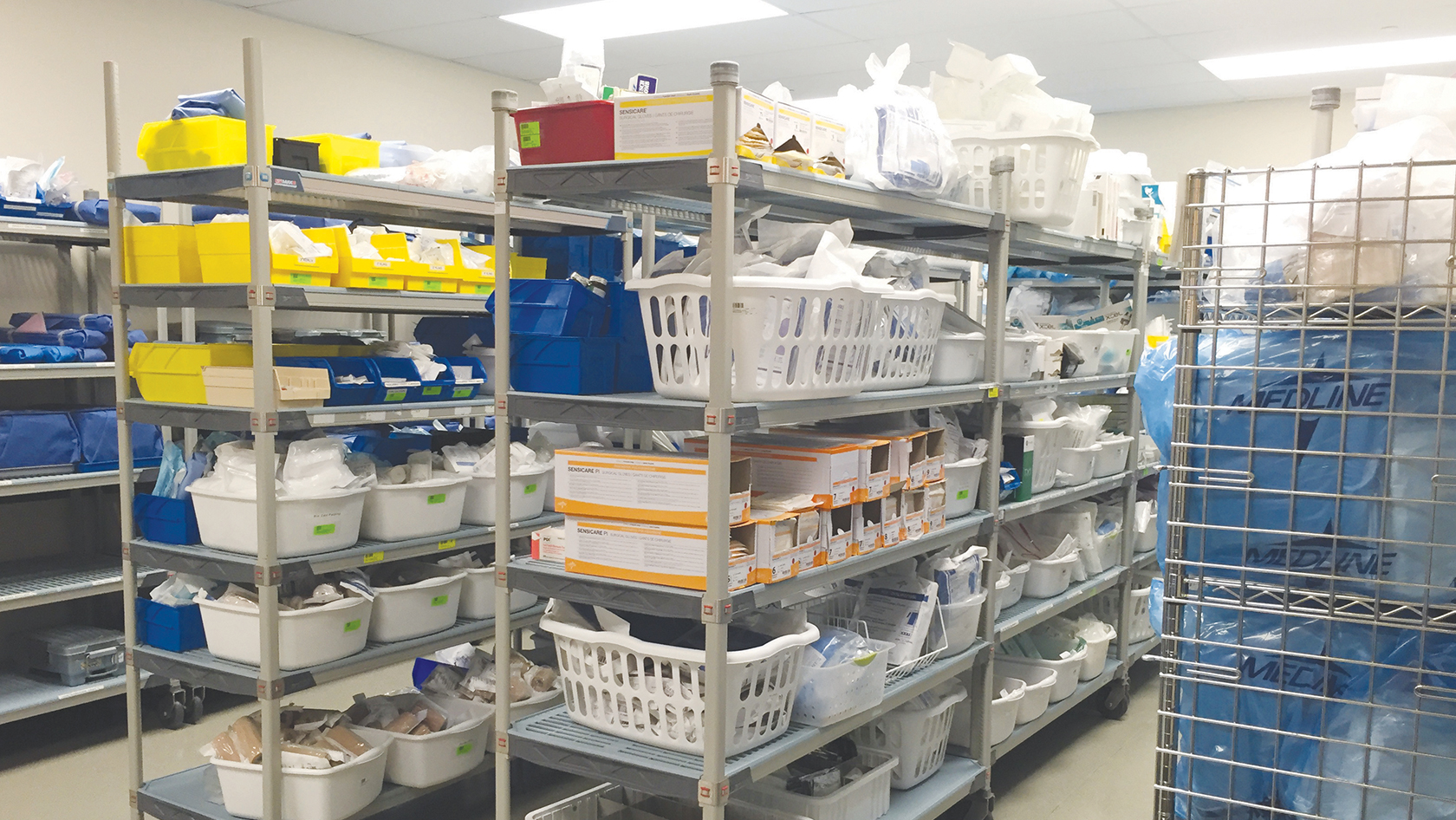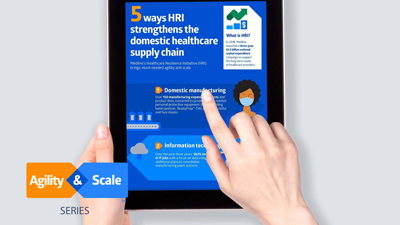Outfitting a new Stanford Medicine hospital at 500 Pasteur Drive
This is what they mean when they say, “Building the plane while you’re flying it.”

When Stanford Medicine and Medline reached a prime distribution agreement in January 2019, it was with the understanding that the two organizations would work together as partners. The health system was looking to Medline to help build a more clinically integrated, resilient supply chain, and at the same time, take on the immediate challenge of outfitting a brand new 824,000-square-foot hospital expansion that was planned to open in 10 months.
And that’s exactly what Stanford and Medline did together.
“It’s rare to be setting up a brand new hospital within the first few months of account implementation—there’s typically a honeymoon period with a new customer,” said Renee Rolle, Medline Account Manager for Stanford. “We signed the new agreement in January, went live in April, started the project plan for the new facility in June, and by September, I was submitting my first due diligence report.”
The culmination of more than a decade of planning and construction, the seven-story medical facility connects to Stanford Health Care’s existing hospital and features 368 private rooms and 35 state-of-the-art operating suites. It is the only Level 1 trauma center between San Francisco and San Jose, and its emergency department is more than double the size of the existing one.
Once fully outfitted, approximately 200 patients were to be moved into the new facility via a skybridge that connects the two buildings. And on that day in November 2019 when Stanford Health Care’s new facility opened, the team was able to report an unadjusted fill rate of 98.9%—one of the highest go-live fill rates the health system had ever seen.
This is a study in agility and teamwork—about what is possible and what can be achieved when teams are challenged and empowered to innovate on the spot, pivot quickly, and make decisions on the front lines and in the moment in support or sometimes even in spite of best laid plans.
Be practical, planful and methodical
“When you think about the number of locations we were opening in the new facility, not to mention the size of the facility, our distribution partner is one of our largest stakeholders,” said Nick Trzeciak, Administrative Director for Distribution Logistics at Stanford Medicine, who was project lead at the time. “With Medline, we not only had to be very integrated but also practical, planful and methodical.”
On one side of Stanford Health Care, all the services the hospital provides were still running and relying on Medline for its daily supply needs. On the other side, everything was starting new—new ship-tos, new routes, new pallet architecture, new units of measure, new test runs, you name it.

Closely working in teams and rigorously running a test environment were essential to making sure everything was good to go on Day 1. A sampling of Stanford and Medline’s litany of priorities and concerns were:
- Making sure forecasts were correct—both a regular forecast and a “fill-the-building” forecast.
- Conducting walkthroughs to verify what locations were on what routes and why, and then making sure those routes were loaded into the pallet architecture.
- Verifying that data would transmit properly—the single most important component, which meant repeatedly testing to confirm IT workflows for each supply location were accurate and start-up orders were correct. Stanford sent test orders for every location to preemptively uncover potential errors: wrong units of measure or account numbers, incorrect item numbers, an inactive ship-to or a missed cost center.
- Determining the best way to verify that orders are correct once they arrived at the hospital and the right number of staff needed to deliver these orders to the proper location.
“I’ve opened several hospitals, and taking these preventative steps upfront resulted in the least active command center I’ve ever been a part of,” Trzeciak said. “We ended up closing our Stanford command center on Day 8 or 9 because of the long hours everyone was willing to put in before we actually flipped the switch.”

The Stanford-Medline team choreographed a plan to ensure that correct items and quantities were delivered to appropriate areas at the best times without overwhelming either the staff or the limited staging and storage space.
Be resourceful when there is no dock and little supply space
With the new facility for Stanford Health Care 10 years in the making and many of the people involved in the original design no longer with the health system, the project team found itself having to start from scratch to design a work flow that would accommodate certain physical constraints—most strikingly, the lack of a receiving dock.
The team’s top priority was to figure out how to get supplies from the original hospital’s main dock to final use locations, which were located 1,000 feet and several floors away in the new facility, in a manner that was efficient and safe for employees. (A tunnel for transferring inventory from the main hospital to the new facility was part of the original design, however, this access between the two buildings would not be completed in time to have supplies in place for the new facility on Day 1.)
The team carved out space in the parking garage and ambulance bay, using a nearby open area to roll U-boats straight off of Medline trucks, up a makeshift incline into the hospital and down a makeshift decline into the building. “The solution compensated for our lack of dock space and kept our employees safe by not having them move a pallet jack worth of supplies a really long distance,” said Katie Dean, Administrative Director of Business Operations and Transformation at Stanford.

In addition, with supply space in the hospital always at a premium and different units and supply rooms becoming available at different and often changing times, the Stanford-Medline team choreographed a plan to ensure that correct items and quantities were delivered to appropriate areas at the best times without overwhelming either the staff or the limited staging and storage space.
Stanford worked with Medline to set up a LUM (low unit of measure) program, ordering a certain number of LUM lines to be picked and shipped daily so that the hospital could identify any par setup or bin sizing issues and resolve them months prior to opening. “It wasn’t about the number of locations in the hospital we were servicing, but rather, how unique the items were and in what units of measure they were going to need them,” Rolle said.
Be like a duck—calm on the surface and paddling like crazy underneath
Forty-six miles away in Tracy, Calif., where a Medline distribution center services not only Stanford but also more than 140 other customers (all of them needing like products), the Medline team was performing a tricky balancing act:

- Ensuring enough stock was on hand to service customers without having to “rob Peter to pay Paul” and avoid stockouts. (Medline does not sequester inventory for any one customer.)
- Placing multiple orders in enough time (at least one month out) to ship in full to locations in the new facility as they were being released. “If we did this too early, inventory could go to someone else,” Rolle explained. “If we did it too late, we wouldn’t have it in time to be there.”
- Ordering double the full amounts (versus half) every two or three weeks, validating these orders with suppliers because of the large volumes, and being careful not to let the orders be captured under historical data.
- Buying items in full case quantities and having mirrored orders for LUM and all the units of measure set up at the same time so that when the main order released, Medline was able to have its own existing orders pending in the system for release. “Everything had to fall like dominos,” said Tracy Butler, Regional DSM Manager, Medline.

Medline did 12 large 100-line orders just to make sure they could receive and stage inventory in their warehouse and get these to the designated locations throughout the new facility. At the same time, branch inventory was being monitored to ensure there was sufficient stock for Stanford’s main hospital, in addition to other area customers.
If an item was discontinued, which is not unusual, Medline identified an alternative and sought approval for its substitute. Also, the list of supplies was ever-changing, with newer things popping up that needed to get into hundreds of patient rooms “basically overnight.”
“Medline and their leadership teams were true partners,” Dean said. “In managing these issues and getting supplies where they needed to be, they were very flexible and in lockstep with us.”
Rolle was onsite daily working closely with the customer. Butler was managing orders and keeping an eye out for delays. The two of them were among about a half dozen Medline people and their teams who worked above and beyond to ensure that from the customer’s standpoint, everything was seamless.
“Communication and collaboration were pushed to the forefront,” Rolle said. “Things were always changing, and we could not pivot unless we knew what was happening. Stanford shared their day-to-days with us, and we used our best judgment based on how things were working, so that every day a cart rolled off a truck with everything needed for people to receive it and deliver it to the right rooms.”
“At the end of the day, we can always talk about project plans and solutions, but it comes down to commitment—being willing to commit the resources and time necessary to doing this work right the first time. And I think Medline was there in spades for us.”
Nick Trzeciak
Administrative Director, Distribution Logistics at Stanford Medicine
Be collaborative, communicative and committed
It’s been right around three years now since Stanford Health Care’s new hospital opened and but for COVID, which demanded even more planning and pivoting, it’s been a process of continuous improvement.
The Stanford-Medline team has rebalanced routes and consolidated trucks, focused extra time on the hospital’s custom areas, and generally streamlined operations. Most importantly, the team has established new communication pathways, huddling daily and calling out issues and challenges in real time.
“At the end of the day, we can always talk about project plans and solutions, but it comes down to commitment—being willing to commit the resources and time necessary to doing this work right the first time. And I think Medline was there in spades for us,” Trzeciak said. “This wasn’t Stanford. This wasn’t Medline. This was a partnership and a collaboration in how to have the most successful outcome and own that together.”




